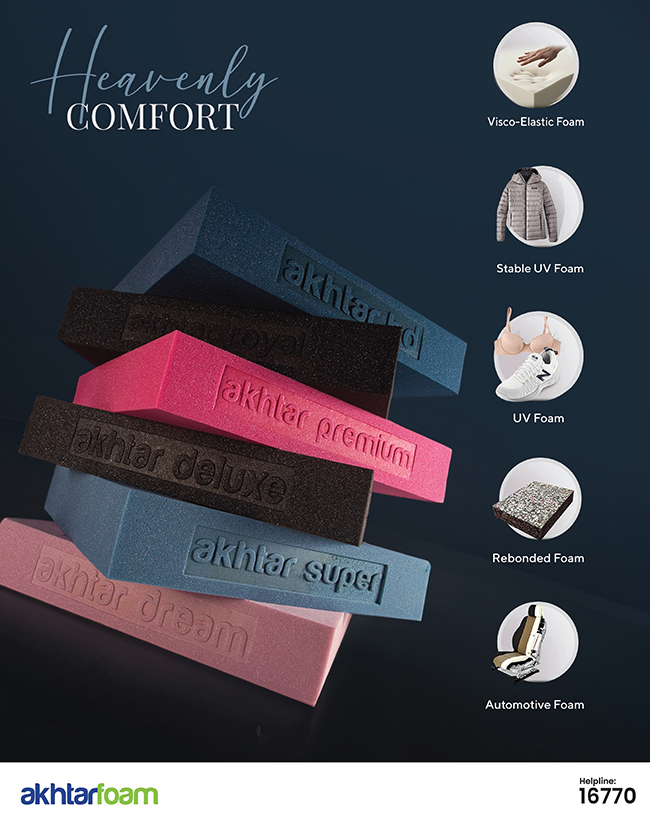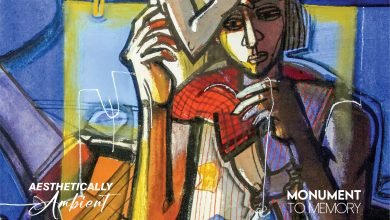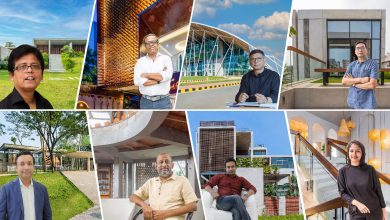Architect Design Studio | Kusum Residence
Zinda Park Eco-Resort is an eco-resort located in the Narayngonj district, spanning over almost 150 acres of land, developed into a space that attracts visitors all year round. Architect Sayedul Hasan Rana is the Principal Architect for this project, which was designed by founder Tobarok Hossain Kusum, who wanted to build the park into an ideal idyllic village that offers modern provisions to its visitors.
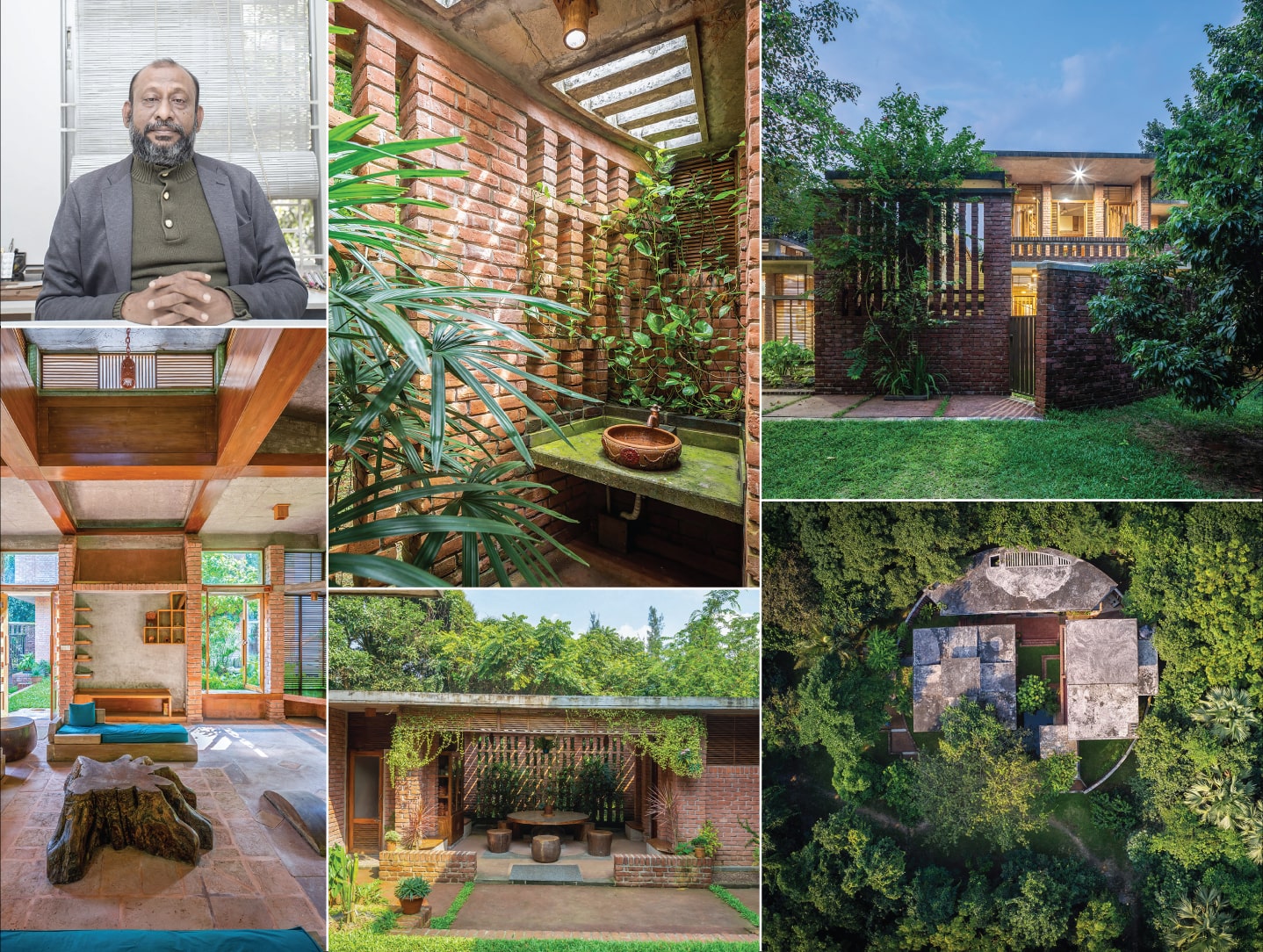
The landscape of the park was already developed when Rana joined hands with Zinda Park and Mr Kusum in 2008. Since then, Rana has been slowly executing Mr Kusum’s original design for the park. At this moment, the park consists of a mosque, a school, rental cottages, a food hall, a library, a community clinic, a delightful house for Mr Kusum aptly named Kushum Bari, large water bodies, and hopefully, in a few years, an auditorium and an institute for folk art and music will be added to it as well.
Kushum Bari is a quaint two-story unit house on the park grounds specifically designed for Mr Kusum, is the crown jewel of the park. It is constructed primarily of red brick and mortar, with wood accents that make up a very charming house.
The space was designed to fit into the park and the surrounding nature.
It is almost like a modern version of an old village home with open courtyards, open-air walkways, and whimsical rooms to stay in. The exterior of the residence has a large courtyard with a small water feature that gives the house a fairytale-like feel. The living room on the ground floor is an ideal place to sit and relax. The high ceiling with the louvres on the top acts as a ventilation system in addition to the almost full-length windows that open up the room out into the nature. A repurposed tree stump acts as a coffee table that pairs excellently with the low wooden seating arrangement. The dining space and the kitchen are a little separate from the main space, boasting a wide round table with tree stumps as seats. There is a surprise staircase that looks like an art installation leading up to the rooftop of the dining space. Off to the other side and up the stairs is another room with a mezzanine floor for additional sleeping areas. The height of the ceilings and the wide glassless wooden windows provide ample light and ventilation for a comfortable stay.
Zinda Park has been 35 years in the making, and it is undoubtedly a fantastic space that has been carefully mapped, planned and executed to perfection.
Architect Profile:
Sayedul Hasan Rana is the Principal Architect of Architects Design Studio and UCI Dhaka. After graduating, he has worked in several private practices on a broad range of regeneration projects in and around Singapore and Bangladesh. These projects emphasize environment susceptibility, low cost and civic urban design. Some of his notable works include Purbachal Library, Turag Shommiloni, RRF TRAC, Jessore etc.
Text by Sophy Ayman Photography by City Syntax
ARC Architecture Consultant | United Corporate Office
United City is a new development where the sponsors are trying to create a swatch of the city a better place in which to live and work. The United Corporate Office is their place of work, right next to the housing, creating a seamless whole of the two worlds. Opting for a comfortable tropical environment for the new United Corporate Head Office, located on a 10 bigha land, abutting a major road, a small canal, their living space, provided the designers with infinite possibilities where a careful prioritizing of the “essential” was needed.
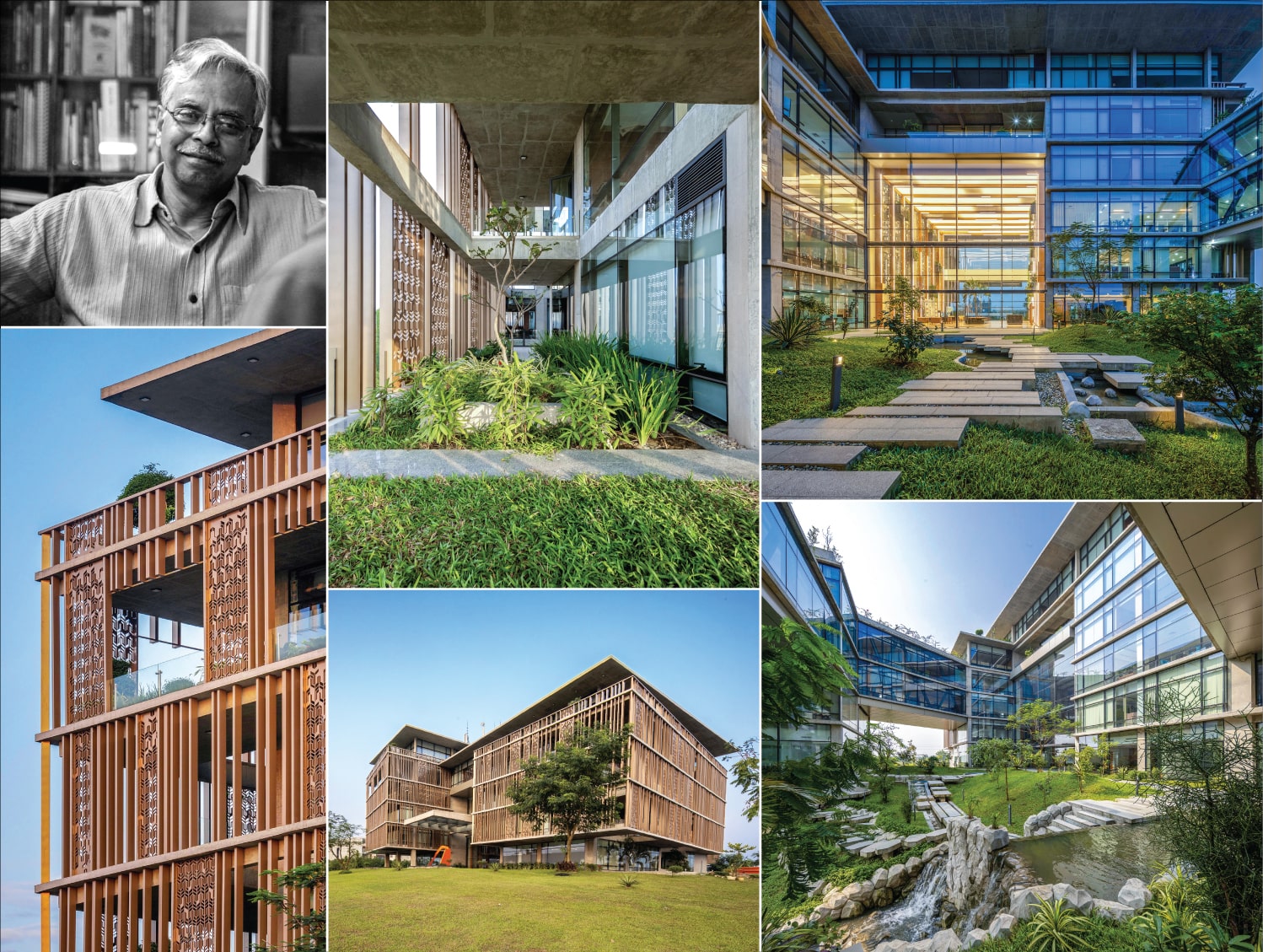
The essential was to create a workspace in a forest-like garden for all who will work here. The nature of the office was determined by making this world of work that complements and completes their living environments. The client required about 1,75,000 square feet Office space. The total built area is 2, 80,000 sft. The footprint of each of the four blocks is 5500 sft of office space with 2000 sft green buffers. The ground level acquires 44000 sft. The design process started in December 2016, and construction began in May 2017. The project was completed in July 2020. Instead of going for an over the top idea, the design team rooted for a simple concept. Once completed and enough time has passed for the plants and nature to take ownership, the office spaces should feel like they have been set inside a forested garden rather than the other way round – placing a “garden” around the office spaces.
Four blocks depict the various sectors in which the United Group is involved. The four blocks are independent yet integrated while complementing each other, all set against the backdrop of nature. The mixed businesses of United Group require a varying degree of segregation. Some allow direct access for visitors, whereas other offices require privacy. A greater degree of independence is offered while at the same time the common Lobby controlling security also infuses all the businesses with a strong sense of strength.
The landscape designed by Celia Lee was just as significant for the experience of the place, if not more, than the architecture itself. The landscape is still a work in progress. The project will not be conceptually complete until the trees already planted, reach a height where the building will be under their canopies. The canal outside was brought into the site by creating a small lake. The dining space is set close to the water bringing in the everyday users from the various businesses of the office close to the water and the intimate nature. The water flows down from the garden adjoining the lobby as if this is the source of the lake and ultimately the canal that ties up the residences as well. The primarily materials used are concrete and glass; however, a good amount of steel has been used for the larger spans to look light. SEED, an international firm, designed the interior of the main areas. The element that ties the architecture and interior is the nature outside.
Apart from the usual constraints, of making the final product look simple, much more effort was needed to keep the structure of the bridge very light and straightforward, so that nature may take the first seat, and all other considerations would take a back seat. The design team involves Ar. Nahas Ahmed Khalil, Ar. Rehman Taki Ferdous and Ar. Md. Asaduz Zaman.
Architect Profile:
Nahas Ahmed Khalil, a distinguished name in the realm of architecture. He was enrolled in Bangladesh University of Engineering and Technology, known as BUET, where he received his bachelor of architecture degree in 1982. His inspiration towards studying architecture was one of the most revered architects, Ar. Muzharul Islam. Some of the other names in the architectural sphere who inspired Ar. Khalil are Geoffrey Bawa, Tadao Ando, Peter Zumthor and Frank Lloyd Wright. Ar. Nahas Ahmed Khalil manages his own venture called ARC Architectural Consultants and created a wide range of successful projects. To name a few are Osban House, Matir Bari, Akash Pradeep, Rashid Eye Hospital, Bengal Bangshibari and South Breeze Square. Regarded as one of the master architects, Ar. Nahas Khalil expresses his enthusiasm and passion for nurturing his designs to continue, till the last breath.
Photography by City Syntax
Archeground | Khanka for a Fakir
Khanka is a spiritual place where Islamic religious masters pray and meet his followers. This spiritual place is built for a Fakir (a Muslim saint) in Goforgaon, Mymensingh, designed by Archeground Ltd. All the design choices are based on a conceptual and constructive restraint, which avoids any monumental approach unsuited to the place and its context, and rather emphasizes the characters of solidarity and hospitality.
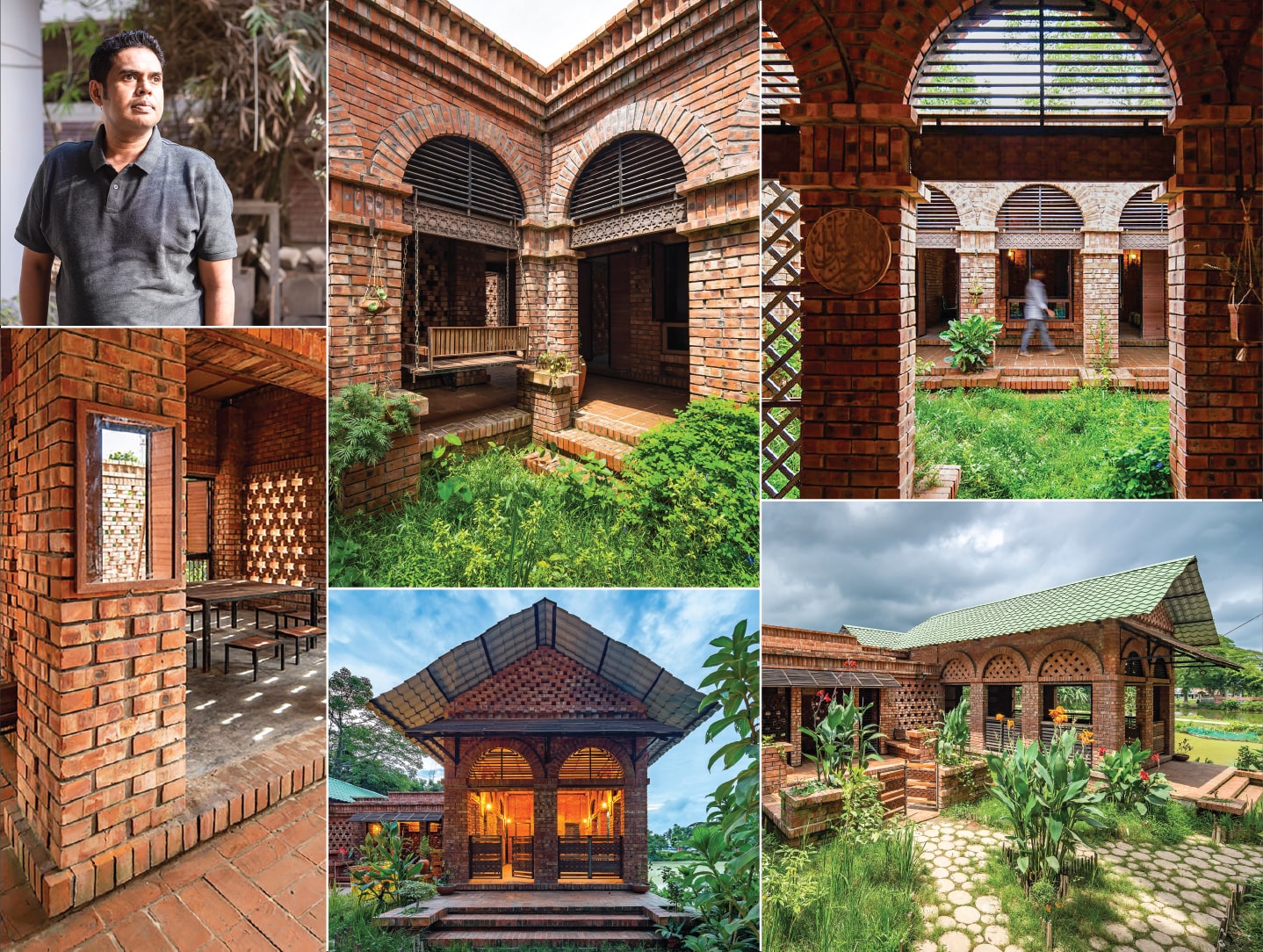
The project has a story behind its establishment. In a Mazar (shrine), A.K.M Shamim Osman, the client of the project, met a Fakir. Gradually he became his follower and decided to build a Khanka with accommodation for the Fakir. The project resides at the road level in the east side while the north and west sides are enclosed with paddy fields which turn into shallow water basin during the rainy seasons. To outpace this complexity in the site, the design team had to retain the edges with plantations. Spanning 360 square-meter built areas, the design emerged from zoning the main programs – a home, a public prayer space dedicated to meeting the followers, and an advanced grave for the master. The main challenge of the design was creating a public function area in a conservative Muslim family. The final layout is divided into three conceptual axes – ‘Live’, ‘Pray’ and ‘Leave’. ‘Live’ denotes the entrance of the home; ‘Pray’ denotes the prayer space, and ‘Leave’ resembles the grave.
The project is an attempt to create a low-cost traditional ‘Bangla Ghar’ with rural architectural characteristics such as the pitched roof and courtyards. The project houses two courtyards, an outer courtyard for public and an inner courtyard for family members who wanted controlled privacy. The inner courtyard as well functions as cross-ventilation, achieving high energy-efficiency and maintenance. An outdoor kitchen courtyard was created in the north-west corner with brick jali (perforated) walls, and toilet zone is placed separate from the bedrooms, following the rural dwelling habit.
The project is entirely built-in local brick and engages local workers for constructions and detailing. For all the rooms and prayer space, pitch roof is made with metal frame and industrial sheet, but the corridor roof around the inner courtyard is made of reinforced brick. One interesting construction feature is the sandwich ceiling panel made of metal frame, coconut fibre and Ferro cement. For floor-finish, brick flooring is given in circulation areas and NCF for all rooms and prayer space. Interior is kept bare with minimum furniture made of metal frame and mahogany wood. “When designing the project, I thought about making use of the materials that would nobly blend in the environment. My purpose was to intervene as little as possible”, says Lutfullahil Majid, principal architect of Archeground Ltd.
“As a Khanka instead of being an iconic structure, considering the rural context we tried to make a simple traditional village house which will not dominate the surrounding nature and the other villagers’ houses. The plan was to design a place of cult and retreat’.
The brick crafted arch enhanced with metal, the brick jali walls, the Islamic pattern calligraphy in brick details and crafted wood m – all amalgamates conveying the splendid Islamic semblance. The Khanka has become a landmark and holy structure for the villagers and the local people who like to symbolize this place as ‘Fakir Bari’.
Architect Profile:
Architect Lutfullahil Majid is the Principal Architect of Archeground Ltd. The Archeground team has expanded over the years and has created a wide range of successful projects. The firm inclines towards unconventional and experimental works and believes on collaboration, discussion and interactive association. This project – ‘A Khaka for a Fakir’ involves its team of architects: Ar. Jubair Hasan, Ar. Nabi Newaz Khan Shomin, Ar. Md. Hasib Mahmud Tipu, Structure Engr. Mosharraf Hossain and Site Engr. Nurul Islam. The team greatly emphasizes environment susceptibility; cost-effectiveness, traditional and vernacular architecture in pursuit of making a better life for its people and the country.
Text by Tasmiah Chowdhury Photography by Maruf Raihan
Design Works Group | Liberation War Museum
The challenge of the Liberation War Museum was to portray all the chronological events of the Liberation War in a symphony under one single roof. The museum structure at Agargaon, Dhaka stands not only as a symbol and representation of the struggle and turmoil of the war but also as a memorial to all nations thriving for independence. Back in 2009, a contest was held for the architectural design of the museum, where architects Tanzim Hasan Salim and Naheed Farzana won the first prize for their designs. Vistaara Architects worked as the associate consultant for the project.
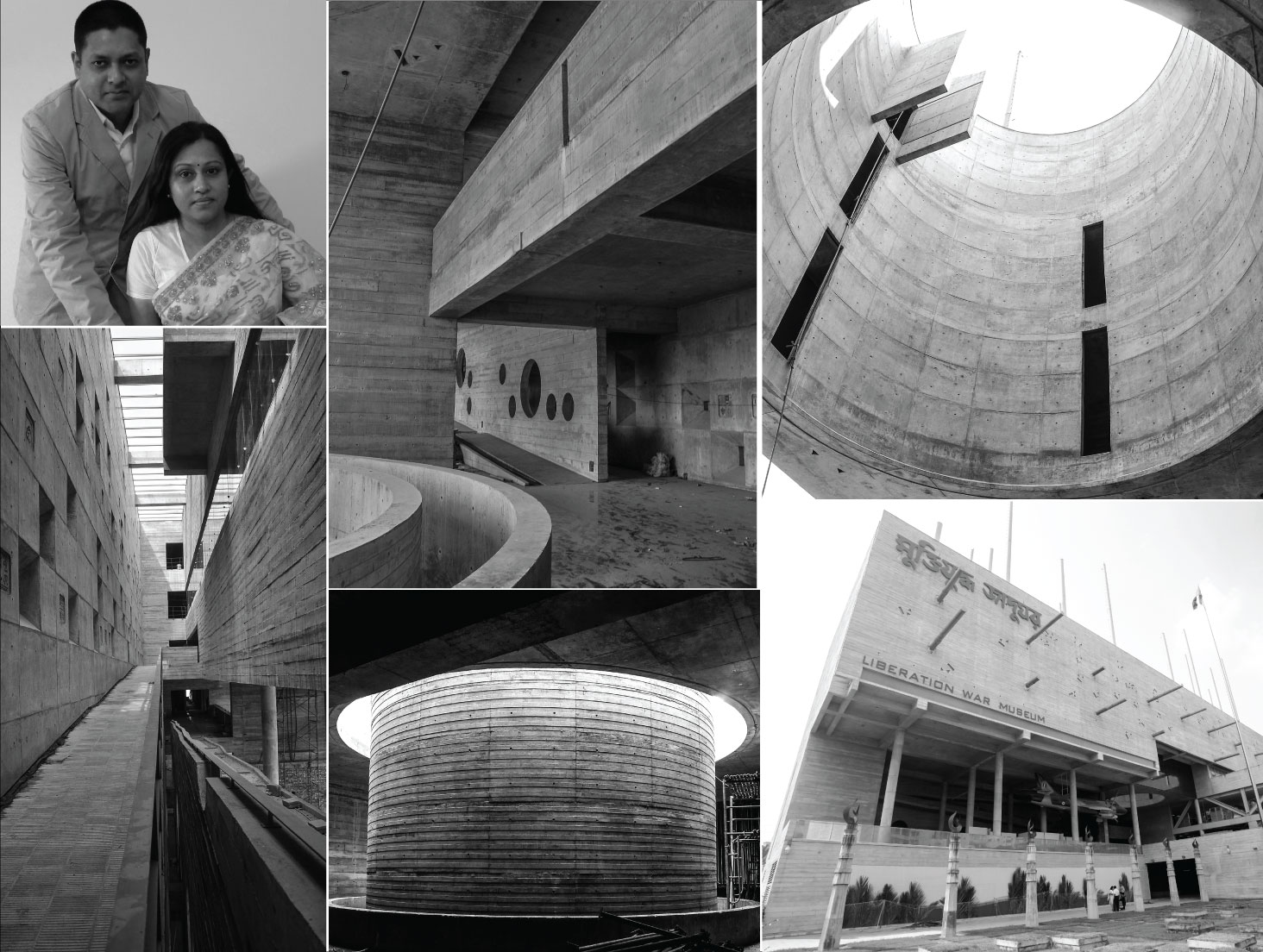
The original museum in Segunbagicha was a two-storied building with six galleries and an outdoor theatre. Since space was scarce for displaying the artefacts in-store, the step for expansion with a modernized approach was considered.
The relocated museum boasts a 1, 75,000 sft approx area with a 3,500 sqm gallery area along with spacious concourse halls and modern audio-visual equipment. The entry guides the visitors to the circular water body depicting the force that holds the flame of eternity signifying tranquillity and homage to the martyrs.
The seven pillars in front of the complex are in memory of the seven highest martyrs (Bir Shreshtos). The most significant part of the project is the chamber of remembrance and realization which comprises a circular void through which sunlight falls upon the water body and the flame below. The light passes through the perforated murals of the wall of history depicting the continuation of human and natural forces of the nation towards its journey through the ages. The formal expression, planning and implication of the Liberation War Museum showcase the spirit of the Liberation war through architectonic expressions.
Architect Profile:
Architect Tanzim Hasan Selim and Naheed Farzana are the partners of the architectural firm DWG (Design Works Group). Established in 2004, their works focus on contemporary designs with functional aesthetics that is contextual, contemplative and progressive. After working locally for a couple of years, Tanzim Hasan Selim went overseas as an architect for AEC consultants in Abu Dhabi from 2008 to 2009. During working there, the firm won the competition for Liberation War Museum, Bangladesh and Tanzim Hasan Selim decided to come back to Dhaka and has been practising in the country ever since.
EK Architects | Playpen School
Founded in 1977, by the prominent educationalist Mrs Zeba Khan, as a kindergarten in her lovely two-story home, Playpen has grown leaps and bounds, expanding to the primary levels in 1998, then evolving to a high school with around 1500 students. Playpen views school premises as a play of spaces and the absence of rigid monotony, so the design goal was to create a progressive learning space that is effective, impactful and interactive, creating a school environment with new pedagogy that allows children to learn from nature, environment and through interaction.
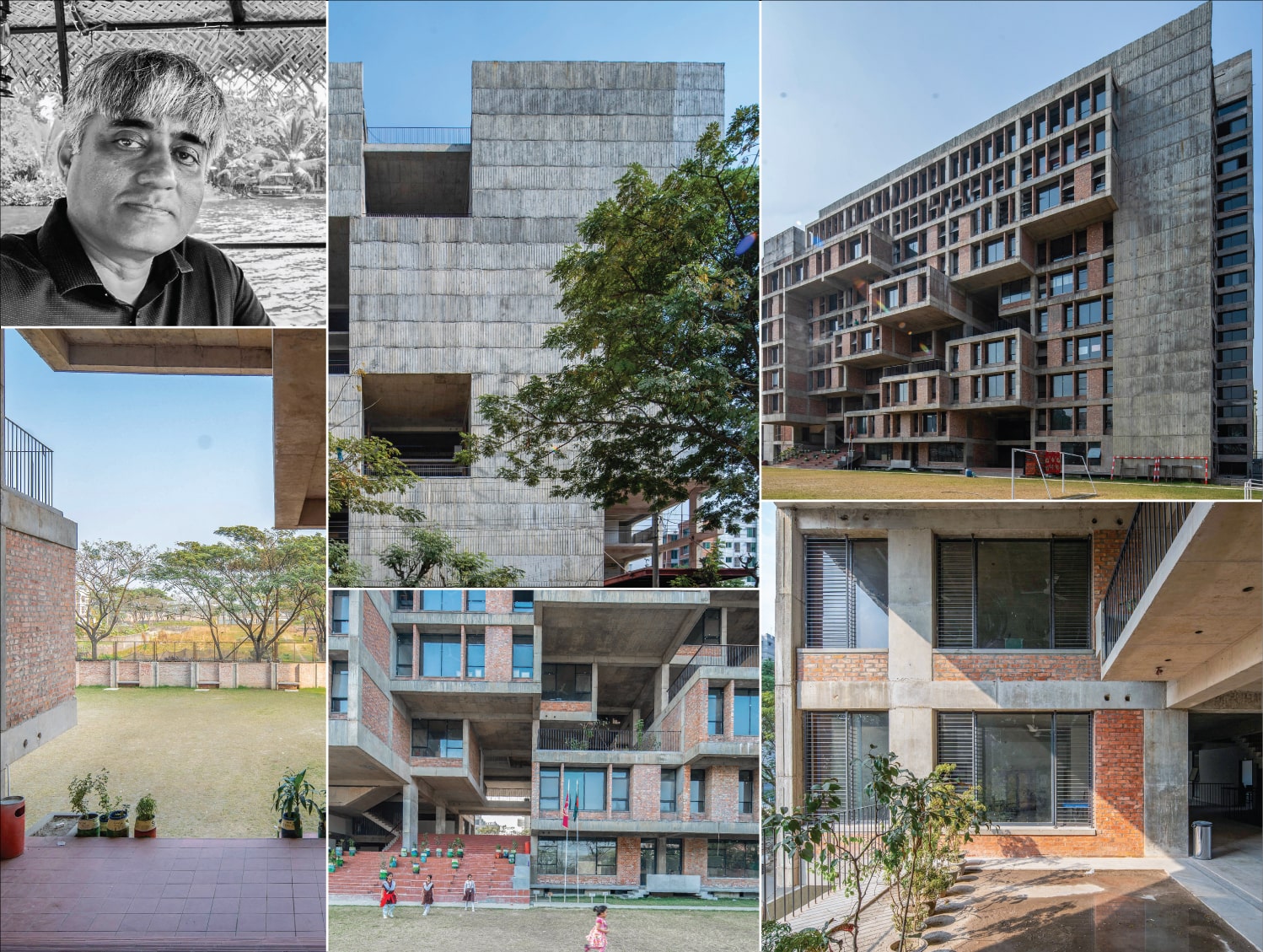
Architect Ehsan Khan, Principal Architect at Ehsan Khan Architects LTD, and his design team Ar. Nusrat Jahan, Ar. Bhuiyan A.R.M. Tareque, and Ar. Safa Binte Safiullah, aimed to create an institution for children who would become responsible citizens of tomorrow, children who live and think holistically with nature, culture, tradition and knowledge. With the support and dedication of the school’s Honourable Chairman, Mr A Mannan Khan and, the Principal Mrs Sorabon Tohura, Playpen continues its 44-year-old traditions from their new premises at Bashundhara Residential Area. The total site area for the school is 5088.74sqm, with only 30% being used for the 10 storied linear structure on the west of the site, while the rest is used as a playground that also acts as a breathing room for the students.
Through voids and collaborative spaces, the entire block is a wall of perforations that protect the building from the heat of the west.
It also creates a dramatic environment that welcomes light. Certain design strategies were applied; the premises must include a large playing field at the east for the children’s mental and physical health, wide circulation corridors that provide a ‘street-like’ experience, small courtyards at elevated levels to be utilized as breakouts and informal learning spaces and diagonal stairs running through the voids of the building connecting different levels.
As an advocate for sustainable architecture, with the tilted roof facing south and solar panels on top, the building can use a significant amount of renewable energy. It was designed with natural light in mind and cross-ventilation. As cast concrete and exposed brick are the primary materials of construction, this reduced the construction cost for the project. Playpen School was designed with as-cast concrete, bare brick façade, a window using locally sourced glass and aluminium, and custom-made precast tiles fabricated on-site to make it unique. The playfield is a breathing void for the neighbourhood. This green playfield is not only for the mental and physical development of the students but also acts as the lungs of the neighbourhood.
This structure is a testament to innovative thinking, creative problem solving, and a space that is designed perfectly for the users of the space.
Architect Profile:
Ehsan Khan completed his bachelor of architecture from Bangladesh University of Engineering and Technology. His notable works include the Mausoleum of the founder of Bangladesh Sheikh Mujibur Rahman at Gopalgonj and Nishorgo Oirabot Nature Interpretation Centre for which he was nominated for the Aga Khan Award for Architecture in 2010. Some distinguished awards under his name are ‘Architect of the Year Award 2002’ for Bangabandhu Sheikh Mujibur Rahman Mausoleum, ‘Berger-IAB Award for Excellence in Architecture 2009’ for Nishorgo Oirabot Nature Interpretation Center, ‘IAB Award for Architecture 2016’ and Honorable Mention of ‘ARCASIA Award for Architecture 2018’ for Mohila Samity Complex. Khan believes ‘one has to be a good human being, to be a good architect’. He strengthens issues on human consumption, human interference with nature, ecology, biodiversity, and urges citizens to be responsible and sensitive toward the world to be presented to the next generations.
Photography by Maruf Raihan Text by Sophy Ayman
Rizvi, Saad and Fatmi| Community Spaces in Rohingya Refugee Response
Community Spaces in Rohingya Refugee Response’ is a series of projects that were a 14-month response to the Rohingya crisis in the Ukhiya-Teknaf area. The architects, Rizvi Hassan, Saad Ben Mostafa, Khwaja Fatmi, designed the spaces with regards to climate, context, and culture that resonated among the Rohingya and the local community to create safe and welcoming spaces.
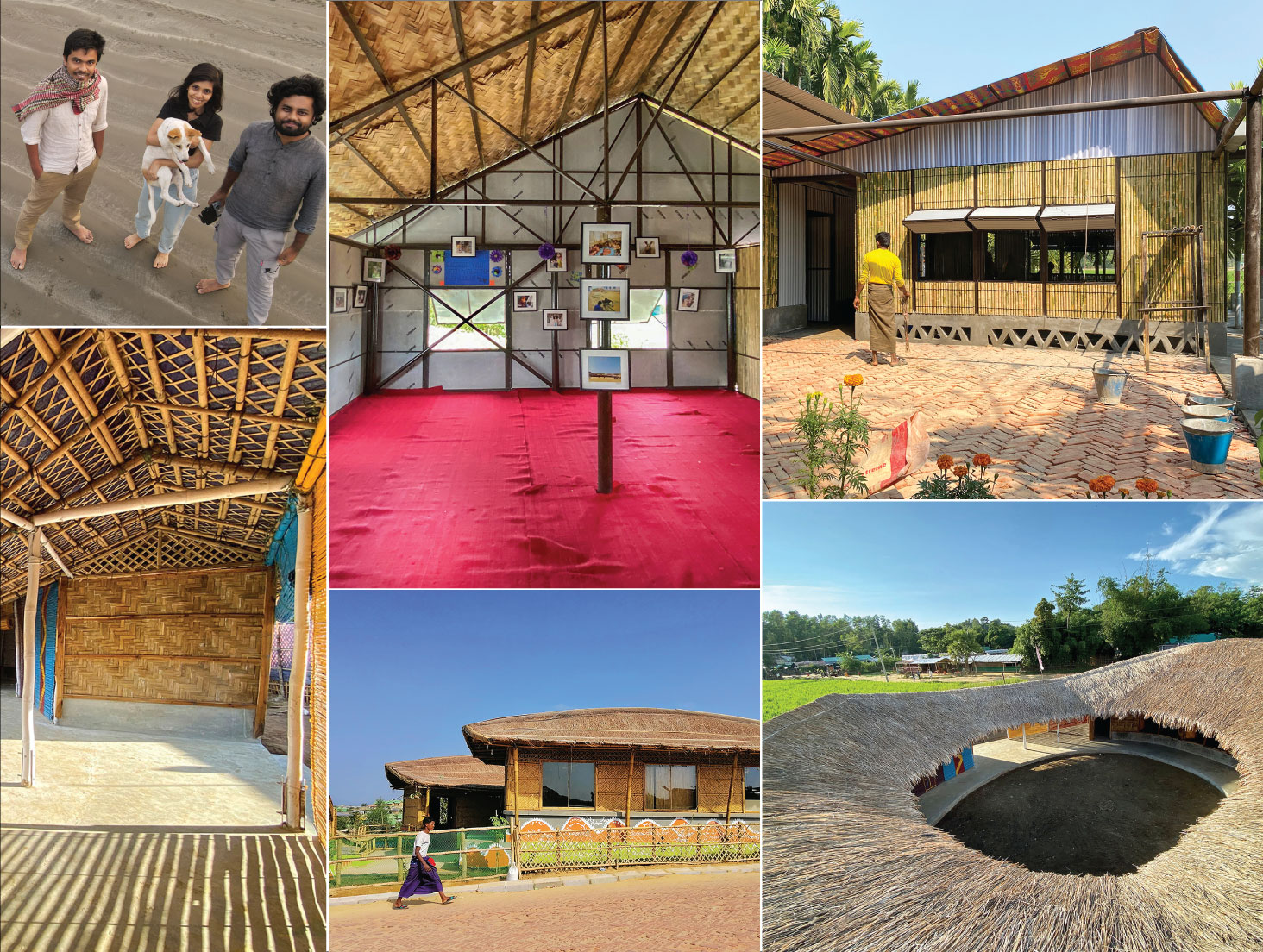
The interventions took place sequentially, in phases, each creating scope of the next intervention. The sequence can be summarized as a quick response to immediate crisis initially followed by engaging community members and artisans in the process to build healable spaces while breaking the gender stereotype in a conservative community, and then developing sustainable and durable schemes in the temporary realm to reduce wastage in this unpredictable context. These interventions were aimed to function as supporting platforms for both collective and individual development in the communities. The first intervention, the Shantikhana, A Women Friendly Space in Camp 4 was built during the post-emergency phase for the vulnerable, oppressed women and girls of the traumatized Rohingya refugee community. The facility comprises 4000 sq ft, building within 7200 sft compound was designed and built within 60 days using Nipa palm, a familiar material for the Rohingya community. The semi-outdoor spaces in-between the roof were joyfully embraced by the visiting women. During transitional phrases between the Post-emergency of influx and development stage, the spatial interventions, Beyond Survival: A Safe Space for Rohingya Women and Girls, Camp-25 was designed to offer a place to have a good bath a day, report abuse and violence while learning and sharing. The socially engaging design and building process influenced the male participants to get their family members involved with the centre.
Locally available materials were used for ease of access and to avoid hazards during a cyclone. The development stage involved the Display Centre and Tailoring Zone, Camp-II which was designed to represent the culture and craftsmanship of communal artisans. The main function of this structure comprises a production space and a display centre which are connected by a large open to sky courtyard acting as a multifunctional community space similar to the concept of a local household.
Involving local craftsmen opened the provision of new ideas, resulting in unique improvisation.
For instance, native unconventional plants made it to the premise that had medicinal values, provided thermal comfort, and is adapted to the adverse environment. The two-storied Community Center in Camp-3 is also designed during the development stage with a combination of natural and industrial materials to create a simple aesthetic that can be replicated easily. Locally made steel skeleton structured the modular partitions with CI sheet, bamboo, cement sheet, etc., and created a designed example of vertical expansion, as well as various use of materials within the temporary realm.
To build relationships and trust between Hindu-para community members and host communities, Caught in Circumstances: An Integrated Community Center in Kutupalong Refugee Camp Hindupara in Kutupalong Rohingya Refugee Camp aimed to improve interaction while introducing sustainable waste management schemes that are contextual and adaptable. Surrounded by a paddy field, in the middle of Betelnut garden, Bhalukia Community Center is a socio-economic support program to ensure long-term development for local ukhiya-teknaf communities. After the success of the modular and deployable design of the Center of Kutupalong of camp 3, the choice of architectural elements to build it was modular and easily replicable. The garden trees were kept uninterrupted with on-site changes to the premise, according to the position of the trees.
This spatial intervention is a seamless conclusion of the entire series that came about from learning and the success of other interventions practices in the past. Organizations offer various support programs that aim to build a healthy and strong community through these centers that have become trustworthy spaces in the barren environment.
Architect Profile:
Rizvi Hassan, Saad Ben Mostafa, Khwaja Fatmi are young architects who graduated with Bachelors in architecture from BUET and is now working in Rohingya Settlement areas in Cox’s Bazar for the past few years, serving for organizations including BRAC, OXFAM GB, IOM, and ActionAid. Saad Ben Mostafa is a Sector Specialist of Technical support unit in Humanitarian Crisis Management Programme, Khwaja Fatmi is a Humanitarian worker, who has been working with various organization as well , Rizvi Hassan, practices architecture focusing on participatory design and sustainable use of materials.
Photography by Rizvi Hassan
Silt | Effluent Treatment Plant (ETP)
The Effluent Treatment Plant (ETP) for Reefat Garments, banked by the river Shitalakhya, is a project curated by SILT that is celebrated rather than concealed. It is located in a site amidst a residential area, near the river, at Kaliganj, Dhaka, covering an area of 77000 square feet.
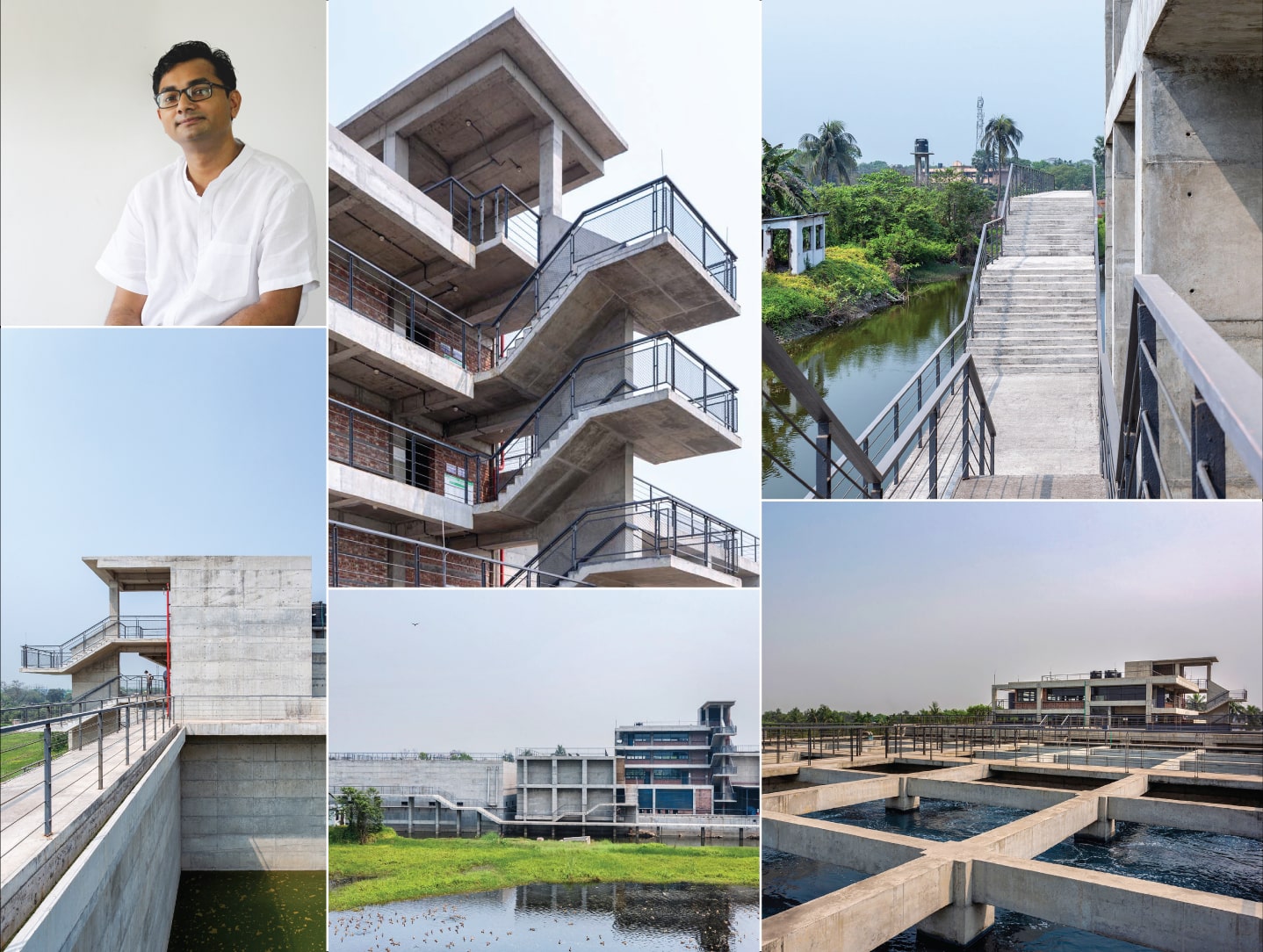
The lead architect Razib Hassan Chowdhury and project architect Sumayia Binte Samad consciously proposed the 400m3/hr zero discharge biological effluent treatment plant that serves the washing and dyeing units of the Ready-Made garments complex for treating the industrial wastewater for its reuse or safe disposal and is now acting to revive the lost balance of the hydrological system. The project is built on a site that had an old state-owned industry repurposed as an RMG production complex. Unfortunately, the previous industrial presence had led to extreme groundwater depletion, adversely affecting the surrounding community along with continuous river pollution. The architects proposed a biological ETP, that ensures the least sludge generation along with little to no foul smell, to reverse the existing water cycle of the production process while acting as a sculptural entry feature to the whole complex as a part of the celebrations of the client’s environmental efforts rather than an undesirable necessity. Upon understanding its importance, the client cooperated with the architects by prioritizing the hydrological system and rejuvenating an existing dead canal, leading to an ecological connection with the river while acting as a river water pretreatment reservoir to the WTP.
To reduce resource consumption, maximum importance was given to utilizing recycled, repurposed, and found materials.
Overall cost minimization of the project due to sustainable construction methods along with international favorable attraction has added to the client’s satisfaction. The targeted ecological resilience was further pushed forward by introducing an inaccessible forest strip on the edge of the canal stretching north to south on the western edge of the RGL complex. The four-storied structure of ETP has been designed as a key component of this cycle where the river becomes the source and the destination, adding various filtration layers in between to ensure maximum purification To further signify its presence as a part of the complex, it is placed in a prominent location and its functions celebrated, by translating them into a sculptural form. Its location also puts it at a favourable distance from the river, increasing the possible number of water quality monitoring points before finally discharging the treated water into the river.
The architects worked closely with the technical consultants to optimize the geometric configuration of the structure resulting in a compact and efficient footprint. Thus, instead of being a stand-alone element, it can become an integral part of the hydrologic system. From placement to formal expression, the ETP has been celebrated and utilized to ensure water quality in every layer of design.
Architect Profile:
Ar Razib Hassan Chowdhury, the Principal architect of SILT, is an architect and researcher who focuses on ecological resilience and integrated sustainability. From microscale efficiency in architectural elements to macro-scale optimization of the ecological footprint of large-scale compounds, he engages in different scales with the context and aims to innovate within the contextual framework while also questioning its limitations. Following his guidance, SILT is a collaborative design research platform that strives to create spaces and experiences that not only address and mitigate the present disparity between people but also bridge the growing disconnect between humans and nature. SILT pushes the boundaries of spatial experiences through intense and efficient design deliberations to achieve holistic design solutions in a shared environment.
Photography by Noufel Sharif Sojol
Studio Dhaka | Teach for Bangladesh Head Office
Located at the dense commercial locale of the Capital’s Gulshan-Tejgaon Link Road, the office building of Teach for Bangladesh is designed by Studio Dhaka. The design philosophy resonates with the Bangladeshi design aesthetics, with rooms that are typically light, airy and bright, with modern furnishings and natural materials. Studio Dhaka Ltd. was handed the challenge to create a more minimalist yet brighter headquarter for Teach for Bangladesh (TFB), which is part of a global movement of young leaders working to end educational inequity in Bangladesh. The young leaders address the educational inequity prevalent in the society through reducing educational disparity in targeted schools and communities while simultaneously building a movement of leaders, who will spearhead the macro-level reform needed to reshape the education system and society in the long run. Since TFB is a donor-based welfare organization, the fund was limited. As a consequence, simplicity, both conceptual and constructive, was a fundamental point.
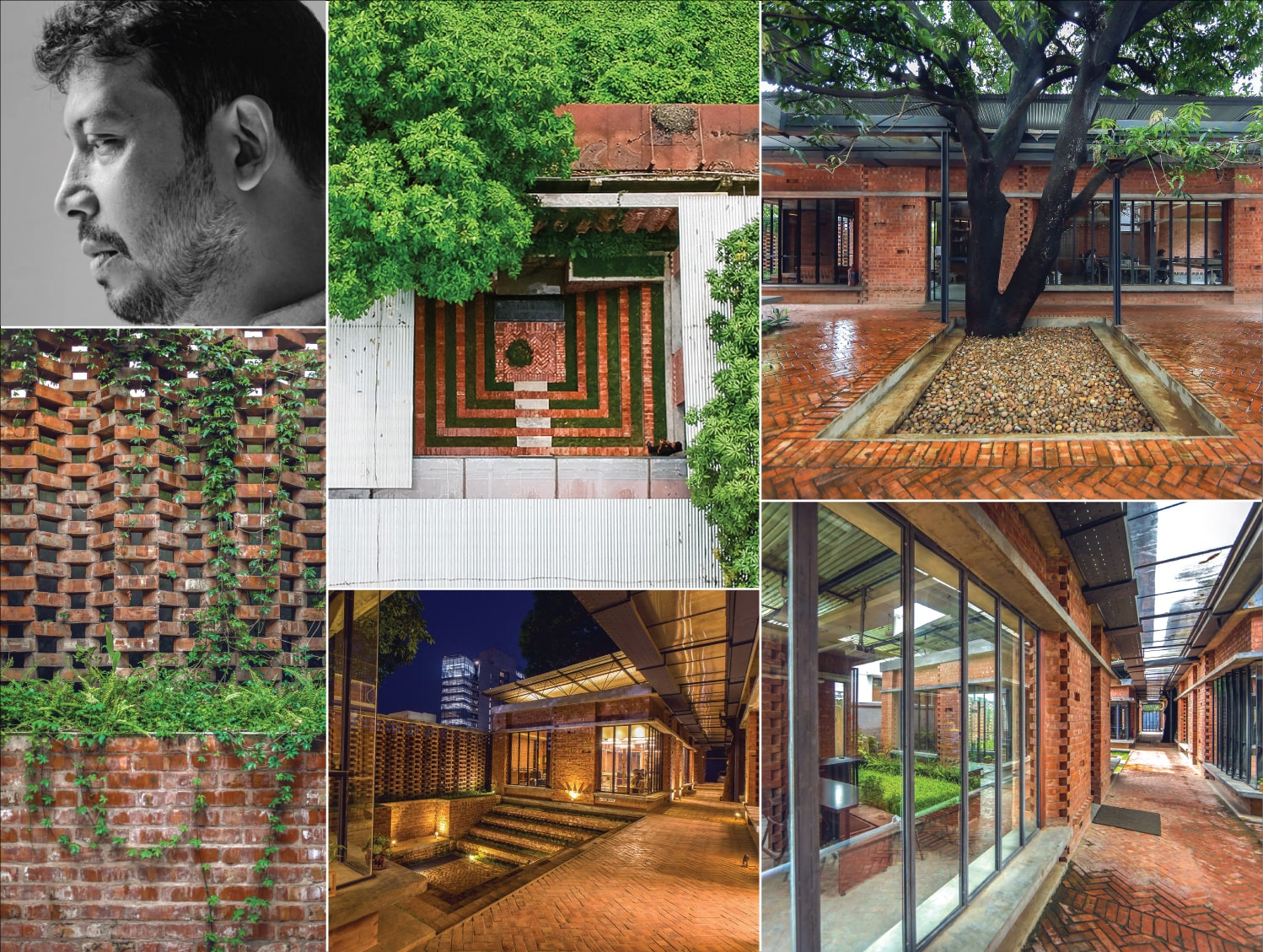
The project considers the local context in terms of resources, building materials, worker’s knowledge as well as social and technical costs.
“The project is entirely built of local gas burnt bricks, corrugated CI and plastic sheets, custom-made mild steel frames for all the openings and cement finish floors take over expensive materials to adorn the structure with environment-friendly materials.”, explains Muhammad Moniruzzaman, Principal Architect of Studio Dhaka.
Low energy consumption was the other major concern. Making utilization of the shadows of the existing trees was therefore mandatory. As a result, pods have been arranged in an alternative manner on the opposite sides of the circulation. To make a very minimum circulation, which is a semi-open space bound by only one-sided wall shared with the pods, the circulation configuration has been designed straight across the site and located in the middle just between the series of the pods. The open-to-air circulation which is full of surprises at every node of the pods starts with a humble reception area and ends with all the services like kitchen, dining area, shower and restrooms. Beside every pod, there is an adjacent open-to-air court. Each of these amicable, introverted courts acts as an oasis not only for the users but also for the neighbours.
For energy-efficiency, multi-layer roofing system of translucent, corrugated plastic sheet roofing beneath CI sheeting has been installed. On top of the roof, trees abound, making a vivid natural canopy so that the heat from the sun dissipates very easily. Moreover, during the daytime, the whole pod gets natural daylight. The trusses to hold the roofing system have been designed with customized MS rods such that it makes the structure light-weight. As part of the natural green landscape, pockets have been designed on brick facades to allow birds make nests. The interior is characterized by a limited palette of materials. Internally the brickwork, along with exposed concrete ceiling and wooden furnishings, creates cool shaded spaces, dappled with the light that enters through the façade. Minimal geometry of the overall volume together with the scarce use of materials makes it possible for the building to humbly adapt to its surroundings. The amphitheatre has been designed to host a gathering of around 100 people as well a large lecture gallery has been incorporated into the design so that the outdoor space, shaded with trees, is often bustling with lively collaborative sessions, workshops, exhibitions or even informal meetings; bringing forth a new discourse within the fraternity and bridging the gap between professionals.
Architect Profile:
Studio Dhaka is a small, intensely design-oriented architectural firm, founded in 2015. Based in Dhaka, Bangladesh, the multidisciplinary firm was established by Muhammad Moniruzzaman with the intent to provide complete, high-level design services for the full range of projects within the built environment, including residential, commercial, industrial and institutional projects. The team takes over everything, from an idea and concept development to realization. Muhammad Moniruzzaman has been awarded as the “Architect of the Year” in foreign category for JK Cement’s 29th Cycle.
Text by Tasmiah Chowdhury Photography by Asif Salman, Maruf Raihan
Vitti Sthapati Brindo Ltd. | Justice Shahabuddin Ahmed Park
Justice Shahabuddin Ahmed Park is set in one of the busiest areas in Dhaka city. Surrounded by a socio-economically privileged neighborhood, this park sustained better than many other parks in the city. The Dhaka North City Corporation initiated the renovation of the park to create a public space that welcomes the residents in an open, green, serene space that is inclusive, safe, and crime-free. Led by Ar Ishtiaque Zahir and Ar Iqbal Habib, with project architect Jinnurain Tasbir Shatil and team Vitti Sthapati Brindo Ltd. the design of the park aspired to incorporate inclusive, appropriate spaces for diverse functions and users into the park by retaining all existing trees and keeping the prevailing ecology untouched, making it the first park in Bangladesh to achieve many of the Sustainable Development’s Goals (SGDs).
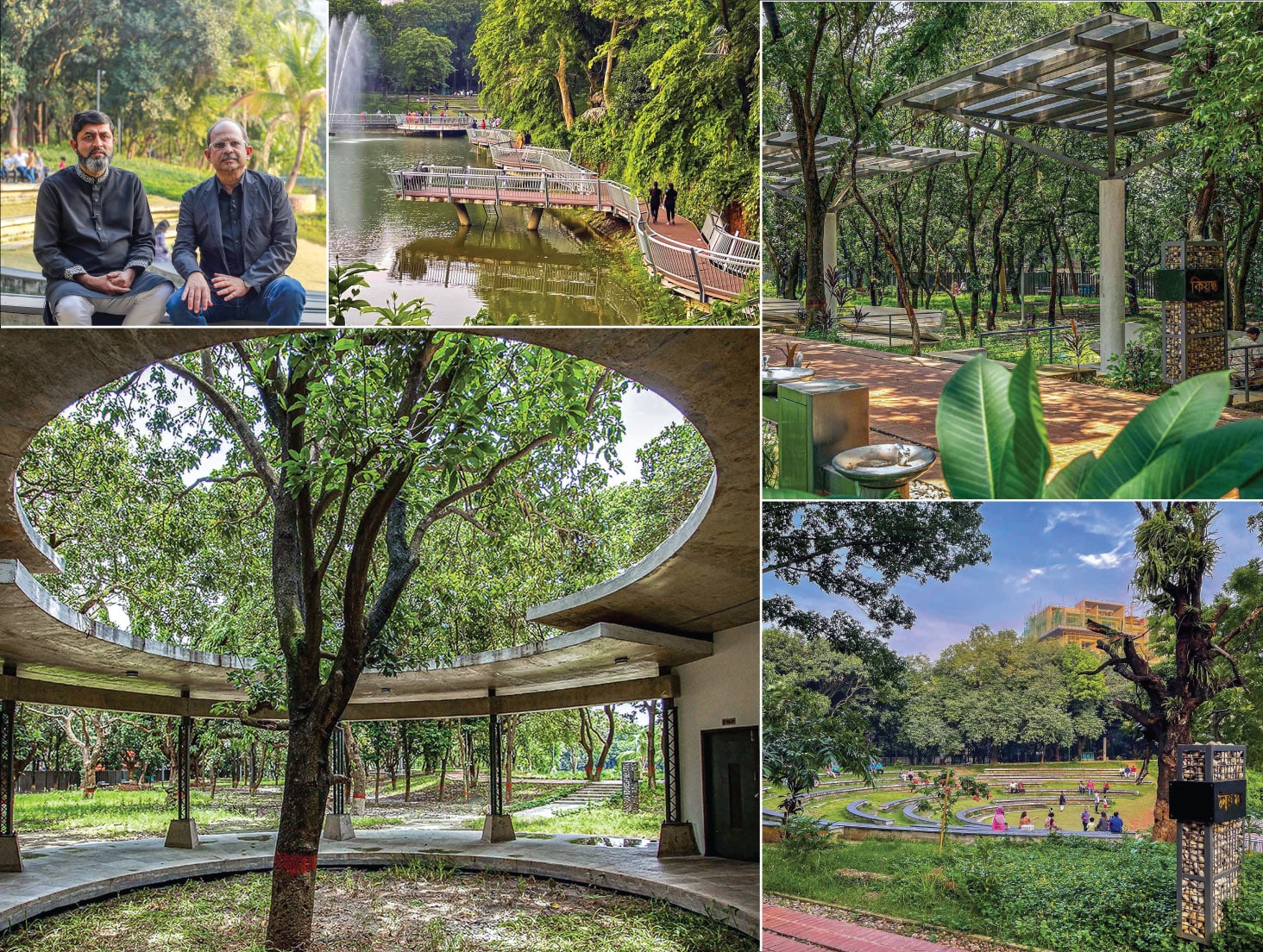
For the last 40 years, the park has been naturally embellished with 1765 trees of different species for creating a shaded, cool environment within. Typically, in the existing parks and playgrounds of the city, there are no comfort zones or universal accessibility for senior citizens, women, youth, children, or physically challenged people. All spaces, nooks and corners are homogenous and without identity. “Dhaka’s parks fell into disrepair and oblivion due to mismanagement and usurping. Policy level work is needed to manage the parks. We don’t want to be guilty to the next generation for the lack of open spaces. So, we worked at policy levels as well, not just as designers. By involving managers, all sections of people, the stakeholder group, the design process was wholistic and it was the biggest achievement of our work”, says Ar. Iqbal Habib.
In order to ensure the public participation, several PRA sessions were held within the local communities to engage and assess their respective requirements that guided the design decisions and implementation. “Our team has constantly tried to collect suggestions from the general people and based on those suggestions, we have tried to be inclusive. We didn’t decide on the design elements- it came from the needs and desires of the people who would be using the park,” explains Ar. Ishtiaque Zahir. “We cannot view the park from an individual aspect. Some may ask that there are many facilities in the park. The answer is our resolve in limited but aspiration in sky high. Dhaka has ¾% space for park and playground. We had to make a balance to reflect people desire. We made an effort to accommodate all these needs while keeping nature undisturbed”, he adds.
To accommodate the diversity of users, there are tectonically five types of paved walkways- Brick Pavement, CC Pavements, Soft Pavements, and Weather proof Wooden Plank Walkways. To recharge groundwater into the soil, water permeable pavement an environmental friendly advanced chemical compound has been introduced for the bicycle lane. The centre of the park is graced by an existing waterbody which was in a state of decline. The waterbody has been re-excavated, re-shaped and re-identified as the jewel of the neighborhood with winding walkways encircling it, viewing decks and three large sitting ‘Ghats’ or decks adorning the three banks. The walkway has been designed on two levels. The lower level offers a refreshing water-side stroll to the users and leads to the viewing decks and ‘Ghats’. The upper level of the walkway is accompanied by a bicycling lane, allowing the users to explore the park’s densely-shaded setting.
A green amphitheater is designed with the lake as the stage backdrop. The amphitheater is complemented by a nearby performance deck and a water fountain. To pave the way to more social engagement, additional functions such as a small snacks corner with a community library, prayer space, kiosks, women’s seating zone, and toilet facilities for both male and female have been incorporated into the design. To promote neighborhood wellbeing, a small gym, a children playground and an outdoor physical exercise yard have been introduced. Moreover, to establish an inclusive environment in the park, the children’s playing spaces have been carefully designed with passive playing equipment and guardian seating provisions. The drainage system of the park has been designed extensively to harvest rainwater. Instead of boundary walls around for security, transparent fencing was introduced, making it visibly open to commuters and pedestrians.
In a bigger lens, the built environment within the park aims to create a connection between all the natural amenities and the variety of users, implementing a green network system. The amenities, the walking trails, the viewing decks- all of these components are carefully distributed within the given landscape to enhance the existing eco-system and nurture bio-diversity. Emphasizing on the need of open public spaces, Ar. Ishtiaque Zahir expresses, “We need to get out of the notion that our city needs to resemble other western model cities and bring forward our own model that is Dhaka. We have to build the city to suit our climate, culture and people, only then this city can be truly ours. Besides buildings, open public spaces should be designed, constructed and conserved across the country, especially in the small towns in all district. It would improve the lives of our people and improve the urban life of our nation as a whole”.
Architect Profile
‘VITTI’ – The Atelier evolved in 1991 as a design studio under the very guidance of the Master Architect Muzharul Islam and it became a limited company in 1993. In 31 years’ time, the VITTI team has grown in to 100 members and it’s led by Md. Ishtiaque Zahir Titas and Md. Iqbal Habib. ‘VITTI’ approaches every design project as an opportunity for new experiments that lead to a creative design solution with responsible & responsive approach. They are well aware of the social and civic responsibilities inherent in all architecture and urban design projects and practices to uphold its values while fulfilling the client’s needs and aspirations by maximizing flexibility, efficiency and economic viability.
Photography by Hasan Saifuddin Chandan, Ar. Wasik Edaaf
Volumezero Ltd | Simpletree Anarkali
Simpletree Anarkali designed by Volumezero Ltd is an ode to a purist architectural response to the oft-chaotic urban fabric of Dhaka. The timeless elegance of reticulate concrete accentuates the clarity of transparent glass planes that forms the exterior envelope. The poetry of horizontal and vertical lines entwine with this grammar to create an urban interest within the emerging commercial spine of Gulshan Avenue.
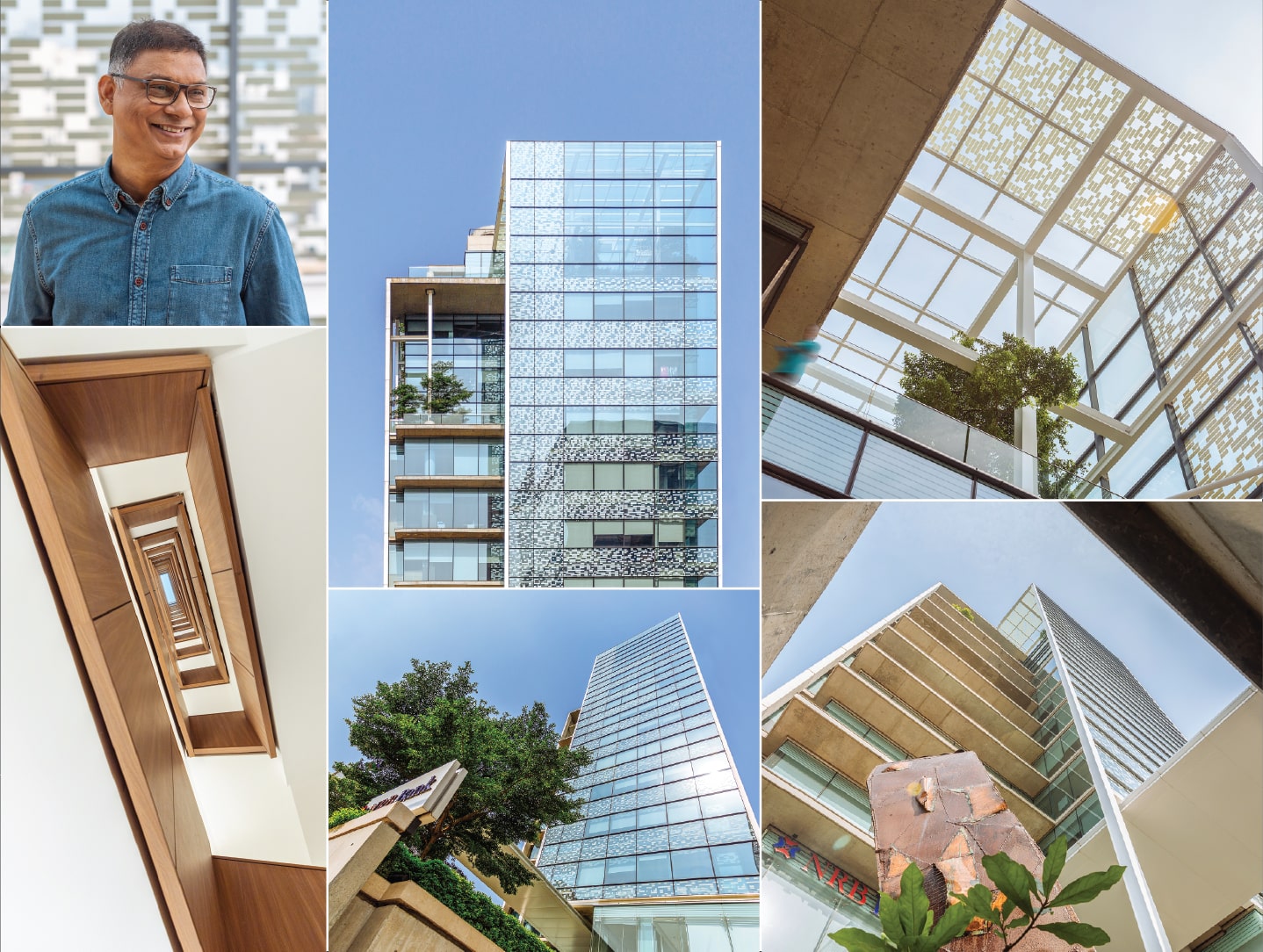
The resplendent forecourt with a generous setback presents a well-curated landscape embellished with cascading waterscape and amorphous sculptures by celebrated artists.
Consistent with the purist approach the canopied drop-off within the realm becomes a preparation portal for the ensuing ambience and elegance. Each of the 1022 square-meter floor plates is a rectangular base supported by a central core and a peripheral service spine, allowing corporate addresses efficient customization within dedicated floors. Apart from being the front-runner in high strata corporate address, Simpletree Anarkali sets a benchmark through a strong sense of environmental responsibilities. Validation of its ability to conserve water, electricity and implementation of environment-sensitive construction methodology came through LEED Certification for shell and core by USGBC, in the gold category – The first commercial building in the country to achieve that feat. The intelligent use of double Low-E, ceramic fritted glazing panel along the west facade maintains the required SHGC (solar heat gain coefficient) value while exhibiting an urban scale artwork along the boulevard.
“As a conscious architectural response, Simpletree Anarkali becomes an urban canvas whereupon pixilated art form reflects the evolution of Dhaka’s socio-economic values – within the chaotic randomness there lays a regulating grammar, repetition of order that breathes life into its expression”, says Mohammad Foyez Ullah, principal architect of Volumezero Ltd.
Architect Profile:
Mohammad Foyez Ullah is one of the preeminent architects of Bangladesh. His academic achievements include distinctions in his Bachelor in Architecture and the “Ahsanur Rahman Gold Medal” in Masters in 1997 from BUET. Soon after graduation in 1993, he continued to be an educator and professional and motivated aspiring architects in architectural schools across the country. Concurrently a successful legacy in the professional field was also initiated when he co-founded Vistaara architects in 1994. As a principal architect of Vistaara, his noteworthy contributions are GP House, Bashundhara City, UTC, The Westin, Peoples Insurance Bhaban, Shanta Western Tower and many more diverse building typologies. Over a decade long successful partnership in Vistaara, Foyez regenerated his practice through Volumezero in 2008. Volumezero has already bagged critical awards for the interior design of its own studio and the high-profile Liberation War Museum Design competition in November 2009. He has won country’s first sustainable building design award “Holcim Green Built Award 2010” for GP House and “Berger Excellence in Architecture 2007” for designing Peoples Insurance Bhaban and “IAB Design Award” for designing a multi-storied family housing in 1998.
Photography by F.M Faruque Abdullah Shawon and H.M Fozla Rabby (Apurbo)

